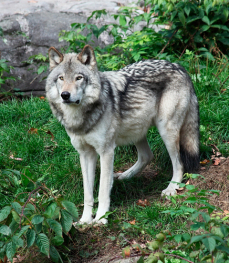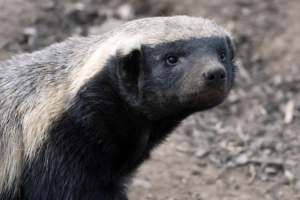By: C.A. Victor
Mammal species include some of the largest animals on earth today, but what is a mammal, exactly? The easiest answer to the question is, well – you. Humans are mammals, after all. But what does that mean, exactly? Mammals are vertebrate animals whose young are (typically) nourished from milk created by special mammary glands of the mother. After all, the word mammal originates from the Latin word “mamma” which means “breast,” which is a reference to that classification. While that basic description is accurate, it doesn’t fully explain the category. So, let’s discuss what makes a mammal and how types of mammals are differentiated within the group.

The Seven Main Characteristics of a Mammal
Humans like to categorize things; it helps us understand the world around us. When we categorize living creatures by their similarities and differences, we better understand their development, and how they relate to other species.
What makes a mammal? There are seven major characteristics that separate mammals from other kinds of animals. These are:
1 – Mammals are covered in hair or fur. In some cases (like those of many marine mammals), they are born with hair and it falls out later, but all mammal species have hair during at least one stage of their lives.
2- Mammals are warm-blooded, possessing an endothermic metabolism. This refers to the fact that they maintain a stable internal body temperature regardless of the external environment.
3 – Mammals are usually born live instead of laying eggs (like birds or reptiles). They feed their young through milk produced from the mother’s mammary gland.
4 – Mammals all have three middle ear bones. These tiny bones – the malleus, incus, and stapes – are known collectively as the ossicles.
5 – Mammals have larger and more complex brains compared to all other groups of animals, including the neocortex region. This region is associated with sensory perception, cognition, and motor controls. Larger, more complex brain anatomy is one of the reasons mammals have higher intelligence.
6 – Mammals have a four-chambered heart (a trait they share with birds!) that is more efficient than the three- or two-chambered hearts of fish and reptiles.
7 – Mammals have a single-boned lower jaw. This gives them a powerful bite. It also allows them to use their teeth to cut or chew (like carnivorous tigers or wolves) or grind down tough plant matter (like cows or elephants).
This collection of traits defines mammals, though some species may be exceptions to one or more of these traits.

Types of Mammals
Mammals are also classified into three types based on the way they give birth and then take care of their young.
1 – Placentals. These are mammals that give birth to live young. The majority of mammals give birth this way. Placental mammals give birth to their young at a late stage of development, meaning they are better able to fend for themselves soon after birth. They include humans, whales, elephants, dogs, rabbits, and many other animals!
2 – Marsupials. These unusual mammals give live birth. However, the young are birthed at a very early stage of development and crawl up the body of their mothers and into a specialized pouch. Marsupials have mammary glands (and teats) in their pouches were their young stay for several weeks. The pouch gives nourishment and protection while they grow! Well-known marsupials include the kangaroo, opossum, and Tasmanian devil.
3 – Monotremes. The last type of mammals is characterized by the fact they lay eggs. However, female monotremes still nurse their young with milk once they are hatched. As adults, monotremes do not have teeth, either. There are only five monotreme species currently: the platypus and four species of echidnas. As all living types are only found in Australia and New Guinea, they are the rarest type of mammal.

Living Environments
Mammals can live in every biome on Earth, including Antarctica. Because they are so highly adaptable, they can also live in a variety of environments around the world. Some – like humans, cats, dogs, bears, etc – are terrestrial animals. In the most basic terms, this means they are animals that live exclusively on land.
Aquatic mammals, on the other hand, spend most of their lives in bodies of water. Some, like dolphins or whales, live their entire lives in water. However, other species, including beavers, otters, and seals, spend time split between water and land. Semi-aquatic mammals also include some species that might surprise you – like the hippo and capybara – which move between land and water in search of food. This group includes the largest mammal on earth – the blue whale.
Mammals can also be arboreal, meaning they spend most or all their lifetime in trees. How much time they spend in trees or out of them depends entirely on the species. Some, like gibbons, tree squirrels, sloths, bats, and koalas, spend most of their lives in trees. It’s especially true of many smaller primates like lemurs, colobus monkeys, and spider monkeys. Others, like many species of cats (namely leopards, marbled cats, and ocelots), anteaters, and opossum all spend a great time on the ground as well as in the treetops.

Interesting Mammal Trivia
• There are over 4,200 known mammal species!
• While the largest mammal is the blue whale (which is generally 21-27 meters long!) the smallest is the bumblebee bat (weighing in at about 2 grams and only 2.54 centimeters in length).
• In most other types of animals, the female of the species is larger than the male. In mammals, males are typically larger than females. This is called sexual dimorphism.
• Mammals are more socially advanced than other types of animals. Social behavior takes many forms. For example, humans have complex social behavior as they exist in cultures based on geography, religion, language, and art. Other mammals – like cows and elephants – live in herds. Lions and wolves also live in groups that exist to help them hunt and remain safe. Even apes have strict dominant hierarchies!
• Humans are the longest living mammal. However, whales can also live up to 100 years!
• Marine mammals must breathe air like all other mammals but they can hold their breath for much longer – sometimes up to two hours before they surface for air.
• Compared to other vertebrates like reptiles and fish, mammals have a high level of parental care. They care for their young after birth, often staying with them for months or years of their development and teaching them essential life skills
C.A. Victor is a freelance writer who does not necessarily share the opinions expressed on BrantaMedia.com.
